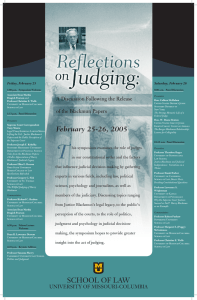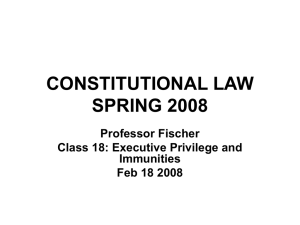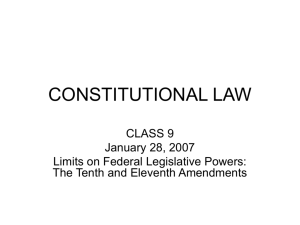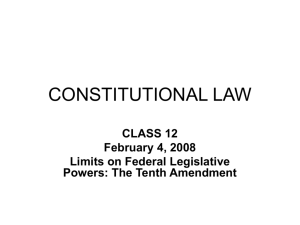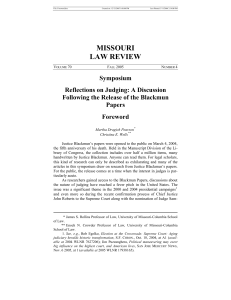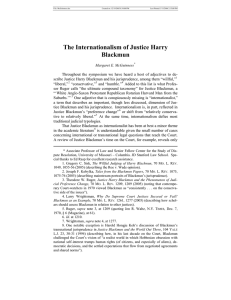Justice Blackmun and the Spirit of Liberty
advertisement
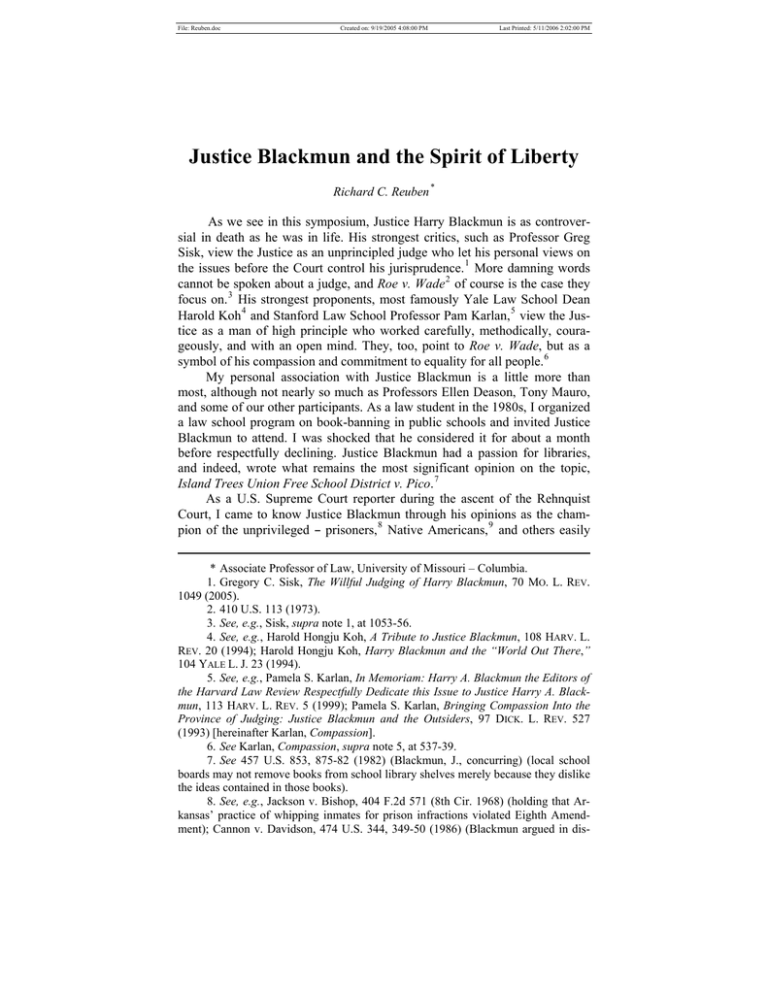
File: Reuben.doc Created on: 9/19/2005 4:08:00 PM Last Printed: 5/11/2006 2:02:00 PM Justice Blackmun and the Spirit of Liberty Richard C. Reuben * As we see in this symposium, Justice Harry Blackmun is as controversial in death as he was in life. His strongest critics, such as Professor Greg Sisk, view the Justice as an unprincipled judge who let his personal views on the issues before the Court control his jurisprudence. 1 More damning words cannot be spoken about a judge, and Roe v. Wade 2 of course is the case they focus on. 3 His strongest proponents, most famously Yale Law School Dean Harold Koh 4 and Stanford Law School Professor Pam Karlan, 5 view the Justice as a man of high principle who worked carefully, methodically, courageously, and with an open mind. They, too, point to Roe v. Wade, but as a symbol of his compassion and commitment to equality for all people. 6 My personal association with Justice Blackmun is a little more than most, although not nearly so much as Professors Ellen Deason, Tony Mauro, and some of our other participants. As a law student in the 1980s, I organized a law school program on book-banning in public schools and invited Justice Blackmun to attend. I was shocked that he considered it for about a month before respectfully declining. Justice Blackmun had a passion for libraries, and indeed, wrote what remains the most significant opinion on the topic, Island Trees Union Free School District v. Pico. 7 As a U.S. Supreme Court reporter during the ascent of the Rehnquist Court, I came to know Justice Blackmun through his opinions as the champion of the unprivileged B prisoners, 8 Native Americans, 9 and others easily * Associate Professor of Law, University of Missouri – Columbia. 1. Gregory C. Sisk, The Willful Judging of Harry Blackmun, 70 MO. L. REV. 1049 (2005). 2. 410 U.S. 113 (1973). 3. See, e.g., Sisk, supra note 1, at 1053-56. 4. See, e.g., Harold Hongju Koh, A Tribute to Justice Blackmun, 108 HARV. L. REV. 20 (1994); Harold Hongju Koh, Harry Blackmun and the “World Out There,” 104 YALE L. J. 23 (1994). 5. See, e.g., Pamela S. Karlan, In Memoriam: Harry A. Blackmun the Editors of the Harvard Law Review Respectfully Dedicate this Issue to Justice Harry A. Blackmun, 113 HARV. L. REV. 5 (1999); Pamela S. Karlan, Bringing Compassion Into the Province of Judging: Justice Blackmun and the Outsiders, 97 DICK. L. REV. 527 (1993) [hereinafter Karlan, Compassion]. 6. See Karlan, Compassion, supra note 5, at 537-39. 7. See 457 U.S. 853, 875-82 (1982) (Blackmun, J., concurring) (local school boards may not remove books from school library shelves merely because they dislike the ideas contained in those books). 8. See, e.g., Jackson v. Bishop, 404 F.2d 571 (8th Cir. 1968) (holding that Arkansas’ practice of whipping inmates for prison infractions violated Eighth Amendment); Cannon v. Davidson, 474 U.S. 344, 349-50 (1986) (Blackmun argued in dis- File: Reuben.doc 1200 Created on: 9/19/2005 4:08:00 PM MISSOURI LAW REVIEW Last Printed: 5/11/2006 2:02:00 PM [Vol. 70 forgotten or trampled upon by mainstream America; 10 the ardent protector of abortion and personal privacy rights, and a beacon for their status within the Court; 11 and, always, the master of the pithy dissent that so often seemed to add a touch of Midwestern common sense and pragmatism to the court’s lofty deliberations. The words of his dissents still ring in my ears. When the Court ruled in DeShaney v. Winnebago County Department of Social Services that a state had no affirmative constitutional duty to thwart a parent’s physical abuse of his child, even if state officials had knowledge of the probability of such wrongdoing, 12 Justice Blackmun dissented: Poor Joshua! Victim of repeated attacks by an irresponsible, bullying, cowardly, and intemperate father, and abandoned by [the state agency] who placed him in a dangerous predicament and who knew or learned what was going on, and yet did essentially nothing except, as the Court revealingly observes, . . . “dutifully recorded these incidents in (their) files.” It is a sad commentary upon American life, and constitutional principles – so full of late of patriotic fervor and proud proclamations about “liberty and justice for all” – that this child, Joshua DeShaney, now is assigned to live out the remainder of his life profoundly retarded. 13 When the court struck down the City of Richmond’s affirmative action program in Richmond v. J.A. Croson Co., 14 a major step in the Rehnquist Court’s march toward a “color-blind” approach to equal protection, Justice Blackmun dissented: sent that prison officials’ failure to protect a prisoner from attack by another inmate gave rise to a cause of action under 42 U.S.C. § 1983); see generally Karlan, Compassion, supra note 5. 9. See, e.g., United States v. Sioux Nation of Indians, 448 U.S. 371 (1980) (holding that an 1877 Sioux agreement effected a taking of tribal property); Employment Div., Dep’t of Human Res. of Oregon v. Smith, 494 U.S. 872, 907-21 (1990) (Blackmun, dissenting) (arguing First Amendment permits Native Americans to use peyote as part of religious practice); see generally Karlan, Compassion, supra note 5, at 528-31. 10. See Karlan, Compassion, supra note 5, at 535-39 (discussing Blackmun’s jurisprudence involving poor women, pregnant teenagers, and gays and lesbians). 11. See Webster v. Reprod. Health Servs., 492 U.S. 490, 559-60 (1989) (Blackmun, J., concurring in part and dissenting in part) (“For today, at least, the law of abortion stands undisturbed. For today, the women of this Nation still retain the liberty to control their destinies. But the signs are evident and very ominous, and a chill wind blows.”). 12. 489 U.S. 189 (1989). 13. Id. at 213 (Blackmun, J., dissenting). 14. 488 U.S. 469 (1989). File: Reuben.doc 2005] Created on: 9/19/2005 4:08:00 PM Last Printed: 5/11/2006 2:02:00 PM SPIRIT OF LIBERTY 1201 I never thought that I would live to see the day when the city of Richmond, Virginia, the cradle of the Old Confederacy, sought on its own, within a narrow confine, to lessen the stark impact of persistent discrimination. But Richmond, to its great credit, acted. Yet this Court, the supposed bastion of equality, strikes down Richmond’s efforts as though discrimination had never existed or was not demonstrated in this particular litigation. Justice Marshall convincingly discloses the fallacy and the shallowness of that approach. History is irrefutable, even though one might sympathize with those who – though possibly innocent in themselves – benefit from the wrongs of past decades. So the Court today regresses. I am confident, however, that, given time, it one day again will do its best to fulfill the great promises of the Constitution’s Preamble and of the guarantees embodied in the Bill of Rights – a fulfillment that would make this Nation very special. 15 Powerful words. In my brief comments today on this symposium on perspectives on judging, I now want to focus on another of Justice Blackmun’s haunting dissents, in Callins v. Collins, 16 in which he finally declared his opposition to the death penalty as presently administered. Justice Blackmun wrote: From this day forward, I no longer shall tinker with the machinery of death. For more than 20 years I have endeavored – indeed, I have struggled – along with a majority of this Court, to develop procedural and substantive rules that would lend more than the mere appearance of fairness to the death penalty endeavor. Rather than continue to coddle the Court’s delusion that the desired level of fairness has been achieved and the need for regulation eviscerated, I feel morally and intellectually obligated simply to concede that the death penalty experiment has failed. It is virtually selfevident to me now that no combination of procedural rules or substantive regulations ever can save the death penalty from its inherent constitutional deficiencies. The basic question – does the system accurately and consistently determine which defendants “deserve” to die? – cannot be answered in the affirmative.17 What I find so striking about this dissent is not its clarity and eloquence but its very public acknowledgment of a personal struggle with a genuinely hard issue, as well as the humanity of Justice Blackmun’s willingness to al- 15. Id. at 561-62 (Blackmun, J., dissenting). 16. 510 U.S. 1141 (1994). 17. Id. at 1145. File: Reuben.doc 1202 Created on: 9/19/2005 4:08:00 PM MISSOURI LAW REVIEW Last Printed: 5/11/2006 2:02:00 PM [Vol. 70 low his views to evolve on the subject. As Professor Charles Alan Wright told the ABA Journal when Justice Blackmun retired in 1994, This is a strength in a judge, rather than a weakness. . . . Most of us don’t like to concede we may have been wrong, and the fact that a Supreme Court Justice is willing to think about things and say to the world, “I was wrong,” to me is an admirable quality. 18 In his article, Professor Sisk sees the Callins dissent as evidence of a transformation in the Justice, from principled conservative to liberal personalpreference pusher who “lost whatever self-discipline he originally possessed and, in the end, allowed his personal preferences full dominion across the field of constitutional jurisprudence.” 19 Professor Sisk duly credits Justice Blackmun for deferring to the democratic processes and upholding the constitutionality of the death penalty early in his career, 20 despite Justice Blackmun’s personal disapproval of capital punishment. 21 But he suggests Justice Blackmun over time elevated his moral opinion to the level of constitutional command, unable, or unwilling, to “hold back the tide of his personal will.” 22 While this hyperbole makes for good entertainment, it also overstates the nuance of reality and suffers for its lack of balance. One may agree or disagree on the merits of whether the death penalty violates the Eighth Amendment’s prohibition on cruel and unusual punishment, but the arguments are hardly frivolous either way B as evidenced by the Supreme Court’s own shifting views. 23 More to the point, just because judges have opinions on issues or connections with parties that come before them does not mean they cannot view the matter objectively and act impartially. In a manner of speaking, Justice Antonin Scalia made that very point just this past term, when he refused to recuse himself from a case involving a personal friend, Vice President Dick Cheney. 24 Setting aside additional concerns about appearances of impropriety in that case, this is part of what judicial professionalism commands: the ability to set aside personal preferences in the interest of objective, neutral, and impartial adjudication B not that one simply abandon all 18. Richard C. Reuben, The Blackmun Legacy: Justice Defined, 80 A.B.A. J. 46, 48 (July 1994). 19. Sisk, supra note 1, at 1066. 20. Id. 21. See, e.g., Furman v. Georgia, 408 U.S. 238, 411 (1972) (Blackmun, J., dissenting) (“We should not allow our personal preferences as to the wisdom of legislative and congressional action, or our distaste for such action, to guide our judicial decision[s].”). 22. Sisk, supra note 1, at 1068. 23. See Furman v. Georgia, 408 U.S. at 380-82 (1972) (Burger, C.J., dissenting). 24. Cheney v. U.S. Dist. Court for D.C., 541 U.S. 913 (2004) (Scalia, J., refusing request by public interest organizations to recuse himself). File: Reuben.doc 2005] Created on: 9/19/2005 4:08:00 PM SPIRIT OF LIBERTY Last Printed: 5/11/2006 2:02:00 PM 1203 points of view once elevated to the bench. 25 Indeed, given the abundance of research on behavioral psychology, only the least sophisticated among us could even suggest this is possible. 26 Finally, let us not forget that conservative judges, including Justice Scalia, are also not beyond ends-oriented reasoning, even under the rubric of strict construction, original intent, new textualism, or whatever the label of the day might be. 27 On the merits of whether Justice Blackmun changed his stance on the death penalty, I am not so convinced. Indeed, in the Callins dissent and his earlier opinions, Justice Blackmun’s struggle with the issue was less about whether capital punishment could be a valid exercise of legislative choice, and more about the question of how a court could be sure it was not permitting the execution of an innocent person. 28 As Martha Dragich Pearson pointed out in a law review article a few years ago, the Callins dissent did not declare absolute opposition to the death penalty. 29 Rather, it reflected his conclusion that it could not be administered with certainty under the current system, and Justice Blackmun’s unwillingness to err on the side of recklessness when it came to matters of life and death. 30 The point is particularly prescient in light of the important role that DNA evidence, unavailable at the time Justice Blackmun wrote the Callins dissent, has come to play in death penalty post-conviction relief efforts. 31 Given Justice Blackmun’s appreciation for science, one wonders how the advent of DNA evidence might have influenced his views in this regard, for if anything did change, it was his belief that the imperfections in the systems could be worked out with appropriate judicial intervention. This consciousness of imperfection is a good thing in a Supreme Court Justice, in my view. Political rhetoric aside, the Justices do in fact make law and set judicial policy, with nearly every decision they render. As Justice 25. ABA MODEL CODE OF JUDICIAL CONDUCT, CANON 3 (1990); see generally JEFFREY SHAMAN ET AL., JUDICIAL CONDUCT AND ETHICS (1990). 26. SCOTT PLOUS, THE PSYCHOLOGY OF JUDGMENT AND DECISION MAKING 15-16 (1993). 27. For criticisms of Justice Scalia’s activism in particular, see Marc E. Johnson, Everything Old is New Again: Justice Scalia’s Activist Originalism in Schriro v. Summerlin, 95 J. CRIM. L. & CRIMINOLOGY 763 (2005); Donald H. Zeigler, The New Activist Court, 45 AM. L. REV. 1367 (1996); Adam Cohen, Psst . . . Justice Scalia . . . You Know You’re an Activist Judge, Too, N.Y. TIMES, April 19, 2005, at A20. 28. See, e.g., Callins v. Collins, 510 U.S. 1141, 1143-46 (Blackmun, J., dissenting). 29. See Martha J. Dragich, Justice Blackmun, Franz Kafka and Capital Punishment, 63 MO. L. REV. 853, 916-17 (1998). 30. Id. at 922. 31. For U.S. Department of Justice case studies of wrongful convictions overturned because of DNA evidence, see EDWARD CONNORS ET AL., CONVICTED BY JURIES, EXONERATED BY SCIENCE: CASE STUDIES IN THE USE OF DNA EVIDENCE TO ESTABLISH INNOCENCE AFTER TRIAL (1996). File: Reuben.doc 1204 Created on: 9/19/2005 4:08:00 PM MISSOURI LAW REVIEW Last Printed: 5/11/2006 2:02:00 PM [Vol. 70 Jackson said in an important death penalty case, Brown v. Allen, “[w]e are not final because we are infallible, but we are infallible only because we are final.” 32 As Tony Mauro points out in his article in this edition, despite their reverence for the Court, for most Americans the Supreme Court is something made of stone and mortar, an institution they learned about in grade school, and maybe saw on a family pilgrimage to the nation’s capital one summer. 33 Such dissents by Justice Blackmun, and the insights provided by his recently released papers, open the doors of the institution and remind us that there are human beings there, too, and that the institution is made up of blood, sweat, and maybe even some tears, as well as stone and mortar and the volumes of cases past. This is something Harry Blackmun never forgot. Mr. Mauro and other symposium participants have suggested that one of the values of having access to materials like the Blackmun Papers is the insight they give into the judge’s actual decision-making process, as opposed to speculation about it. 34 In this regard, Professor Ellen Deason’s article paints a very different picture of Justice Blackmun than that painted by Professor Sisk. 35 The context of Professor Deason’s inquiry was the validity of contractual provisions calling for the arbitration of statutory claims. 36 This is not nearly as politically charged as the death penalty or abortion, but it is still a hard question because it involves removing cases involving rights granted by a legislature from the public courts. At issue was whether the Federal Arbitration Act, which overturned centuries of common law refusal to enforce predispute arbitration agreements, should be construed to apply to statutory claims. 37 In its earliest significant ruling, Wilko v. Swan, the Court had said no, the right to access the courts was not waivable by statute, specifically the Securities Act of 1934. 38 Then, in a series of cases in the late 1980s and early 1990s, the Supreme Court reversed field, dramatically expanding the reach of the FAA in the domestic and international contexts. 39 Justice Blackmun appeared to be inconsistent in these cases. In Mitsubishi Motors Corp. v. Soler Chrysler-Plymouth, Inc., Justice Blackmun took a broader view of arbitrability under the FAA in joining the majority in holding that an automobile distributor’s antitrust claim against a foreign manufacturer was arbitrable under the FAA, even though the Act did not speak to the inter- 32. 344 U.S. 443, 540 (1953) (Jackson, J., concurring). 33. Tony Mauro, Lifting the Veil: Justice Blackmun’s Papers and the Public Perception of the Supreme Court, 70 MO. L. REV. 1037 (2005). 34. See id. at 1040. 35. Ellen E. Deason, Perspectives on Decisionmaking from the Blackmun Papers: The Cases on Arbitrability of Statutory Claims, 70 MO. L. REV. 1133 (2005). 36. Id. 37. Id. at 1139-42. 38. 346 U.S. 427 (1953). 39. See Deason, supra note 35, at 1156-79. File: Reuben.doc 2005] Created on: 9/19/2005 4:08:00 PM SPIRIT OF LIBERTY Last Printed: 5/11/2006 2:02:00 PM 1205 national context. 40 Later, however, Justice Blackmun took a narrower view of arbitrability, dissenting in a case upholding the arbitrability of claims under the Securities Act of 1933. 41 That case paved the way for the Court’s 1989 decision in Rodriguez de Quijas formally reversing Wilko’s contrary ruling under the 1934 Securities Act. 42 Later, he turned around yet again and joined the majority in Gilmer v. Interstate/Johnson Lane Corp., upholding the compelled arbitration of a statutory age discrimination case, 43 probably the most significant expansion of the FAA in the history of the Act. Deason suggests the Blackmun papers help explain, at least in Justice Blackmun’s case, a voting pattern that might appear inconsistent when seen solely through the lens of arbitrability doctrine. Deason lays out this argument at length in her discussion of Sherk v. Alberto-Culver, the first real test of Wilko. 44 The case dealt with an American manufacturer’s claim that he had been defrauded under the Securities Act of 1934 by a German seller of businesses with respect to trademarks. 45 The contract said claims arising out of the transaction would be decided by international arbitration, but the American manufacturer wanted the case to be heard in an American court. 46 Because only one member of the Wilko Court, William O. Douglas, was still on the bench, the Scherk case presented the Burger Court with its first opportunity to give Wilko a hard look. 47 If it liked what it saw, it could extend Wilko. If it did not, the Court could distinguish or even reverse. Working from the Blackmun Papers, Deason reports how Justice Blackmun laid out the conference positions of several of the Justices: Chief Justice Burger (“Muddy,” dismiss as improvidently granted); 48 Douglas and Brennan (extend Wilko); 49 Stewart and Powell (hostile to Wilko, distinguish 40. 473 U.S. 614 (1985). 41. Shearson/Am. Express, Inc. v. McMahon, 482 U.S. 220, 242 (1987) (Blackmun, J., concurring in part and dissenting in part). 42. Rodriguez de Quijas v. Shearson/Am. Express, Inc. 490 U.S. 477 (1989). 43. See Gilmer v. Interstate/Johnson Lane Corp., 500 U.S. 20 (1991). 44. 417 U.S. 506 (1974). 45. Id. at 509. 46. Id. at 508-10. 47. Chief Justice Warren’s chair was held by Chief Justice Warren Burger; Justice Hugo Black’s chair was held by Justice Lewis F. Powell; Justice Felix Frankfurter’s chair was held by Justice Blackmun; Justice Sherman Minton’s chair was held by Justice William Brennan; Justice Thomas Clark’s chair was held by Justice Thurgood Marshall; Justice Stanley Reed’s chair was held by Justice Byron R. White; Justice Harold Burton’s chair was held by Justice Potter Stewart; and Justice Robert Jackson’s chair was held by then-Associate Justice William Rehnquist. See generally, WILLIAM COHEN & JONATHAN D. VARAT, CONSTITUTIONAL LAW: CASES AND MATERIALS 1685-87 (7th ed. 2001). 48. Deason, supra note 35, at 1147. 49. Id. at 1147-48. File: Reuben.doc 1206 Created on: 9/19/2005 4:08:00 PM MISSOURI LAW REVIEW Last Printed: 5/11/2006 2:02:00 PM [Vol. 70 as inapplicable); 50 White (on the fence). 51 Justice Blackmun proceeded to draft a memo demonstrating the tension between Wilko and another international arbitration case, M/S Bremen v. Zapata, 52 and explaining why, on balance, he supported the majority’s decision to extend Wilko and affirm the enforceability of the arbitration agreement under the FAA. 53 The charge could easily be made that Justice Blackmun was engaging in ad hoc decisionmaking. However, Deason argues that Justice Blackmun’s records for those cases showed a methodology that was anything but arbitrary. “One can see him giving credit to arguments on both sides of the case . . . [and seeking] a compromise that could accommodate business interests in enforceable arbitration agreements [while providing] the means to effectuate the statute’s public policy.” 54 Justice Blackmun was still struggling with the fundamental issues in 1991, she writes, when his notes from the Gilmer case showed him literally itemizing on a piece of paper the arguments for and against arbitrability of statutory claims, before ultimately joining an opinion with which he was obviously uncomfortable on pragmatic grounds, saying in his notes “arbit[ration’s] ti[me]s h[a]s arrived.” 55 To be sure, the papers show that the Justice had opinions B including of the advocates at oral argument 56 B but they also show a meticulous notetaker, a methodical thinker, and an inveterate judicial balancer. How many of us, for example, would really divide a piece of paper into eight squares and use that to track the arguments and preferences of the other eight Justices for each case throughout a career that lasted nearly a quarter of a century? 57 And here, as Tony Mauro suggests, is the real value of the Justice Blackmun Papers and other such insights into the internal workings of the Court. 58 When faced with such strongly competing images of the Justices as we have with Justice Blackmun, it is helpful to be able to go behind the opinions to see what they were concerned about, the arguments they considered and rejected, why they phrased things certain ways. Justice Blackmun knew all too well how controversial he was, and left behind papers that will provide scholars a basis for assessing his actual work, beyond the political spin of competing ideologies. Justice Blackmun also left behind a challenge for future judges. I return to the candor and open-mindedness of his Callins dissent, which in my view 50. Id. at 1148-49. 51. Id. at 1148. 52. M/S Bremen v. Zapata Off-Shore Co., 407 U.S. 1 (upholding dispute resolution clause calling for treating of international shipping disputes arising under the contract before the London Court of Justice). 53. Deason, supra note 35, at 1149-51. 54. Id. at 1149. 55. Id. at 1177-79. 56. See Mauro, supra note 33, at 1045-46. 57. See Deason, supra note 35, at 1136 n.10. 58. Mauro, supra note 33. File: Reuben.doc 2005] Created on: 9/19/2005 4:08:00 PM SPIRIT OF LIBERTY Last Printed: 5/11/2006 2:02:00 PM 1207 both legitimizes the institution and provides it with humility. We live in a time of increasing absolutism, where things are either black or white, red or blue, you are either for me or against me, my way or the highway. It is when we are swayed by the sirens of absolutism that we are most likely to make mistakes, for absolutism diminishes our capacity to see nuance, much less to appreciate and account for it in our reasoning. 59 This is a dangerous thing in a court, and in a democracy. As Learned Hand so wisely said in 1944: “The spirit of liberty is the spirit which is not too sure it is right.” 60 Judge Hand’s words ring particularly true in these polarized times, and Justice Blackmun’s example shows us that even a U.S. Supreme Court Justice can embrace this kind of humility. 59. See, e.g., Christina E. Wells, Fear and Loathing in Constitutional Decision Making, 2005 WISC. L. REV. 115, 158-91 (2005). 60. Learned Hand, The Spirit of Liberty (1944) in LEARNED HAND, THE SPIRIT OF LIBERTY 190 (Irving Dillard ed., 3d ed. 1960).
